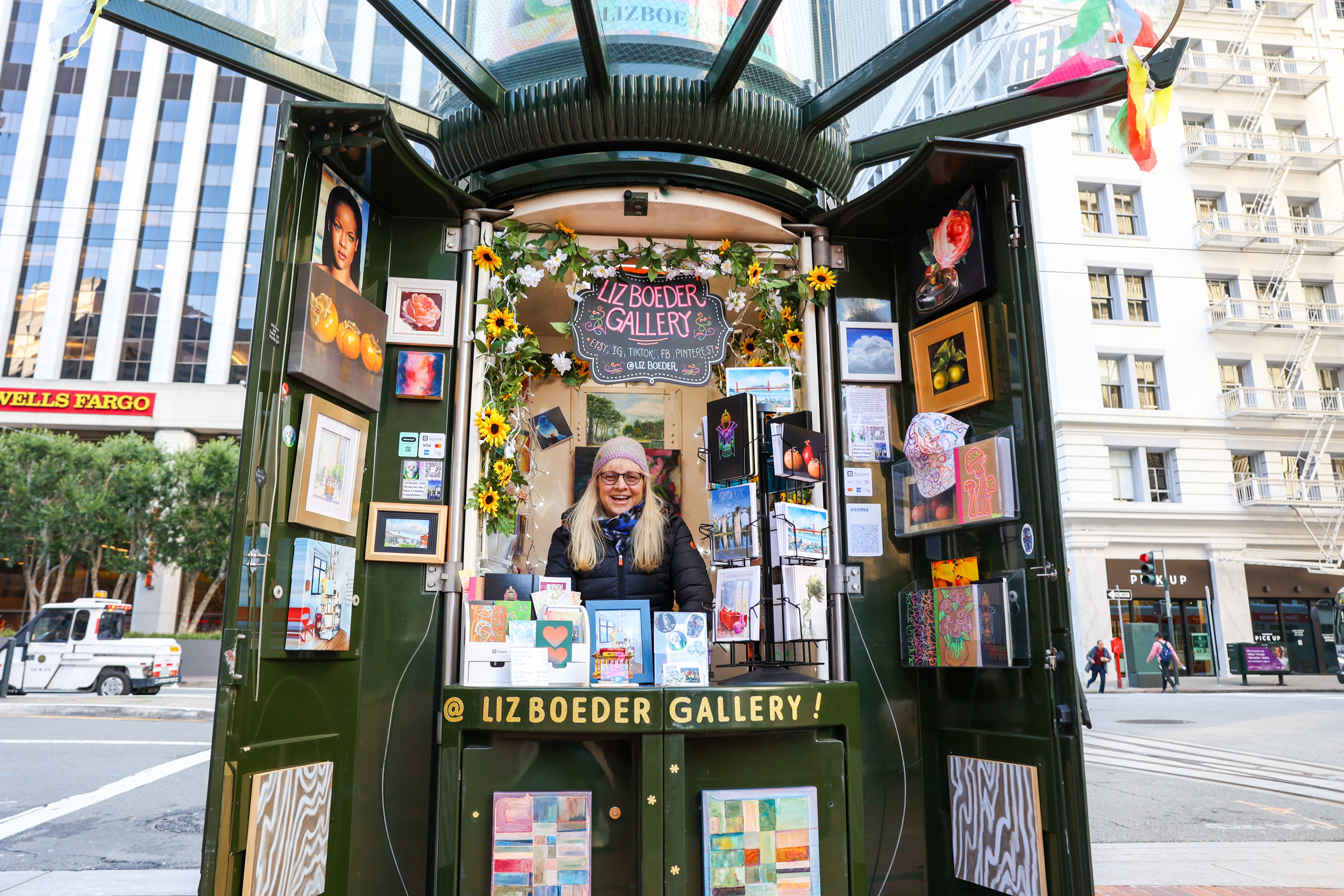You never know what you’ll see when strolling down Market Street these days, but odds are, it won’t be charming. But thanks to an effort that brings together the city’s Arts Commission and the international marketing giant that owns over 100 advertising stands peppering Downtown, local artists like Liz Boeder have turned old-school newsstands into personal galleries, as a means of showcasing their artwork while bringing much-needed charm to beleaguered sidewalks.
As one of the first artists to be selected, Boeder had her pick of newsstand locations. Each had perks and drawbacks, but she’s happiest near the California Street cable-car turnaround, where she posts up for approximately 15 hours a week (she’s on the honor system; plus, she has a by-appointment-only gallery in Potrero Hill). Many of her prospective customers are tourists just trying to orient themselves, with questions like “Where is Market Street?” or “How do I get to the Ferry Building?” Both make her chuckle.
Usually, to show work on this scale, artists need to rent canopies and tables, with no promises of making any money. But this project, which is still accepting applications, is free.
The JCDecaux Kiosk Activation Program prioritizes “local artists from San Francisco, and their wares have to be crafted themselves, not retail,” according to JCDecaux Executive VP Francois Nion, who came up with the mutually beneficial arrangement.
The history of the newsstands are outlined in an SFGate article that first highlighted Boeder. Once the city’s contract with JCDecaux to sell newspapers had expired, and in keeping with the digital age, the contract was expanded so that goods other than print media could be sold at the kiosks.
In Boeder’s case, she’s adorned the Parisian-style cylinder with faux sunflowers, her celebrity portraits, stickers and oil paintings, which light up the cable car stop she’s parked at.
Her presence in the stand has led to some incredible opportunities.
“When this first started, I told myself, ‘Don’t get your hopes up! You won’t start selling hundreds of dollars to pedestrians on Market Street.’” Boeder said. “And now, I’ve sold paintings worth hundreds of dollars!”
Her works are available for sale or rent—for the commitment-phobes among us—and she also accepts crypto, though only one customer has taken her up.
By “applying classical techniques in unexpected ways,“ Boeder’s work reflects the beauty of daily life, poking fun at the apocalyptic view of San Francisco that outsiders seem to have these days. The unexpected wholesomeness of a mini art gallery in a vintage newsstand is a welcome sight on the main road, in a destination recently devoid of its usual hustle and bustle.
“If it’s legit, it’s unique and, if what you craft-create attracts the public, then it’s a match!” said Nion of JCDecaux. “And at street level, it creates activity, which is good. It’s what we need.”
This project is his brainchild, but in coming months, the green cylinders, which are reminiscent of Paris’ bouquinistes—those traditional booksellers on the Seine—will get replaced.
Remember the futuristic toilets that made headlines? Same vibe.
According to Nion, JCDecaux’s goal is to continue installing the new toilettes and slowly also to replace the kiosks.
“If, along the way, we can keep helping local artists, we would like to,” he added.
As for the classic green newsstands, their future is uncertain. Boeder has dreams of buying them to create yet another artist’s space. She imagines creating an entirely new tourist attraction, a permanent mini flea market made up of vintage stands, strung together with fairy lights. In her daydreams, there’s live music playing while people shop from local artisans.
But JCDecaux has no definitive answers.
“Is there a way to repurpose some of them? Or all of them? Maybe,” Nion said.
He’s open to it, but there are a lot of moving parts.
“Everything is possible, but when you have a contract like the city, everything has to be to scale,” he said. “So it’s a question of timing. When we are ready to replace them, will there be a place for them to go?”
